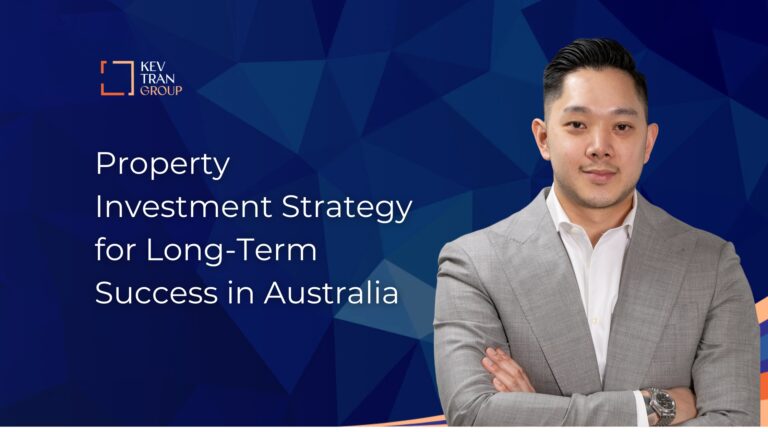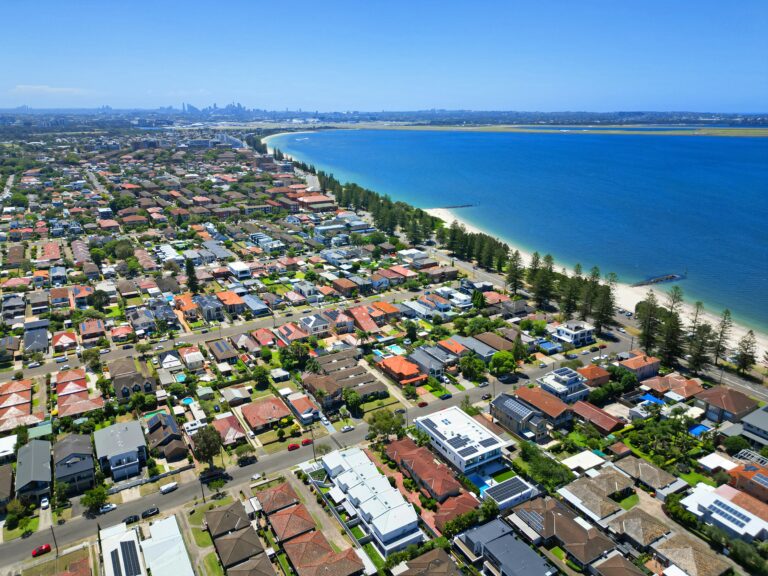Steps to Building a Property Portfolio That Delivers Strong Returns
Most investors stop after one or two properties. In fact, 90% never get past their second purchase, not from lack of ambition, just no clear strategy. Building a property portfolio that delivers strong property returns comes down to buying the right assets, not the most.
This guide walks through the exact steps to invest in property using Kev Tran Group’s proven process. It’s the same portfolio investing strategy we use with time-poor professionals earning over $200K. If you’re serious about how to build a property portfolio that works long term, book a call to map it out.
Step 1 – Get Clear on Your Freedom Number
Start with the End Goal in Mind
Before you even look at a property, you need to know why you’re buying it. Building a property portfolio without a clear outcome is like flying blind. This is where your Freedom Number comes in, a realistic income target that replaces your job and funds the life you want.
It’s not about retiring early or owning massive properties. It’s about knowing your personal target and working backwards to hit it. Whether it’s $80K or $250K per year, the strategy needs to match your timeline, income needs, and risk appetite.
We help clients reverse-engineer their goals into a property investment roadmap that actually makes sense. That means testing assumptions with real numbers, not just chasing headlines or hotspots. What you want is strong property returns that hold up over decades, not hype-driven purchases.
If your goal is income in 10 years, you’ll need assets that generate high cash flow. If your timeline is longer, you might lean more into capital growth. Your portfolio investing strategy should reflect that balance from the start.
We use data to work out how many assets you’ll need, what they should deliver, and when they’ll need to perform, that’s how we keep the plan grounded. It also helps you avoid buying properties that feel like progress, but block your next move.
Step 2 – Map the Right Portfolio Strategy
Align With Budget, Borrowing Power, and Buffers
Once you know your Freedom Number, the next step in building a property portfolio is mapping a strategy that fits your real-world limits. We start with your borrowing power, available funds, and buffer needs, not ideal scenarios, that’s how we turn goals into a working property investment roadmap.
Every investor needs a tailored plan. A dual-income family with two kids and a $1.5M borrowing capacity will need different assets than a high-income solo buyer with $700K to spend. We reverse-engineer the right asset type, price point, and cashflow profile based on what you’re trying to achieve.
For some, it’s about layering in positively geared properties to protect lifestyle. For others, it’s using high-growth assets with refinance opportunities down the line. Either way, your portfolio investing strategy should reflect what your numbers can actually support, not what’s trending.
We also stress-test each plan to make sure it works if the market shifts, that includes interest rate rises, vacancies, or personal life changes. Our aim is strong property returns that hold up under pressure.
Step 3 – Buy the Right Asset, in the Right Market, at the Right Time
Asset Selection is Where Most People Get Stuck
Most investors stall after one or two properties because they bought the wrong asset. It’s rarely a lack of intent, it’s poor balance between capital growth and cash flow that kills momentum, that’s why smart portfolio investing strategy starts with the right purchase, not just any purchase.
We see this all the time. Someone buys close to home because it feels familiar, not because it stacks up on the numbers. It’s how people end up with apartments in oversupplied markets, when they could’ve secured better-performing assets elsewhere.
When you’re building a property portfolio, you need to be open to value markets. We’ve had strong results in areas like Toowoomba, Adelaide, and fringe suburbs of Melbourne, where the data supports both yield and growth. It’s not about guessing, it’s about matching the market cycle with the asset profile that fits your plan.
This is where our due diligence comes in. We assess over 20 risk and return factors before green-lighting any property, from flood zones and power lines to local income levels and infrastructure spend. Every asset has to support the larger property investment roadmap, or we move on.
Don’t Just Chase Hype – Use Data to Drive Every Decision
Strong returns don’t come from assumptions, they come from data-backed decisions. Every property must balance capital growth, cash flow, and market cycle timing to earn a spot in your portfolio. So before moving forward, we stress-test every deal, even when it looks good on the surface.
Inexperienced investors often skip key checks or rely on gut feel, we don’t. Our due diligence checklist covers more than 20 core factors that impact both risk and return.
Before any property makes it into your plan, we assess:
- Flood and bushfire risk (can affect both value and insurance)
- Proximity to public housing and infrastructure detractors
- Local market heat and recent comparable sales
- Rental yield consistency and area vacancy rates
This process helps us avoid the biggest trap, buying a property that looks fine today but can’t support portfolio growth tomorrow. A deal might tick the growth box but kill your cash flow, or vice versa. We only move forward if it fits the broader property investment roadmap.
Step 4 – Keep Cashflow Strong Enough to Sleep at Night
Positive or Balanced Cashflow Trumps Theoretical Growth
You can’t build long-term wealth if you’re stressed every month, that’s why one of the most important steps to invest in property is protecting your cashflow. It’s not about the biggest upside, it’s about staying in the game.
We’ve worked with investors who bought growth-heavy assets that drained their monthly budget. The capital gains looked good on paper, but once rates rose or repairs hit, they were forced to sell.
We always model real holding costs upfront, insurance, land tax, council rates, repairs, and more. We don’t rely on best-case scenarios, we use conservative figures so you know what the property will cost and what it will earn.
Sometimes that means going for positive cashflow, other times, it’s pairing a growth play with a yield buffer to keep your strategy sustainable. Either way, the goal is strong property returns that won’t disrupt your day-to-day life.
If you’re not sleeping well, you’ve gone too far. We design your portfolio investing strategy to support both your long-term vision and your current lifestyle, because if your properties own you, they’re not assets.
Step 5 – Don’t Just Buy One. Build a System
Portfolio Building is a Repeatable Process
Building a property portfolio doesn’t stop at the first buy. Every purchase needs to set up the next. In turn, you go from one good asset to a scalable strategy that builds real wealth.
We use a repeatable process to ensure each property unlocks the next move. This includes targeting equity growth, planning the refinance window, and keeping buffers intact. Otherwise, investors hit a wall after property number two.
Take Jason and Samantha, they started with a single purchase in Adelaide, using a 20% deposit and a solid yield. Twelve months later, we helped them access equity to fund their second buy in regional Victoria.
By the time we went for property three in Toowoomba, their buffers were still strong and their portfolio was delivering positive cashflow and long-term growth. Every deal moved them closer to their Freedom Number, with a clear property investment roadmap from the start.
This isn’t about buying ten properties, it’s about stacking the right ones, in the right order, with the right strategy. In doing so, we help clients achieve strong property returns without taking on unnecessary risk.
Step 6 – Avoid Common Traps That Kill Momentum
The Wrong Property Can Stall You for Years
When you’re building a property portfolio, one wrong move can freeze your progress for years. It’s why we say not every property is a stepping stone, some are dead ends, and most of the time, the damage comes from what investors didn’t check.
Buying off-the-plan, chasing shiny new builds, or sticking to comfort-zone postcodes are classic traps. These properties often have inflated prices, low land value, or tight lending restrictions, and once you’re stuck, it’s hard to get moving again.
The fix is proper due diligence. We screen for flood and bushfire risk, odd lot shapes, public housing ratios, and zoning quirks that most investors overlook. It’s about protecting both your upside and your exit options.
Another common issue, no buffers. We’ve seen investors forced to sell during interest rate spikes or personal emergencies, just because they didn’t build breathing room into their portfolio investing strategy.
Our rule is simple, every asset needs to add momentum, not just look good on a listing. We use this principle to help clients avoid the painful mistakes most investors make on properties one or two.
Final Word – Strategic Portfolios Create Freedom, Not Stress
Building a property portfolio isn’t about how many properties you own. It’s about what they do for your life. More isn’t better, better is better.
The goal isn’t 10 properties and burnout, It’s choosing high-performing properties that create income, build long-term wealth, and give you more freedom, not more stress. In other words, smarter always beats bigger.
We help clients build portfolios that pay them, not the other way around. It’s a system grounded in data, due diligence, and a clear endgame. Every move is mapped out in a simple, executable property investment roadmap.
No matter where you’re starting from, progress comes from having a clear strategy. For this reason, we work with busy professionals to turn scattered steps into a focused plan. In the end, structure is what creates momentum.
Want to know how to build a property portfolio that actually gets you where you want to go? Book a free call and we’ll walk through your numbers, your goals, and your next best move.
Because the right portfolio investing strategy doesn’t just create wealth. It gives you back control of your time.







